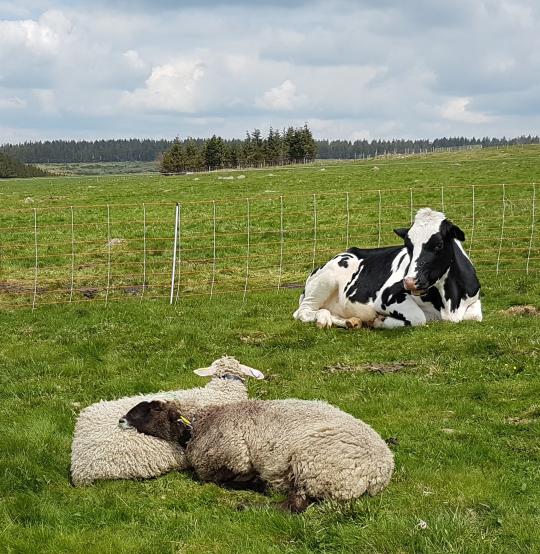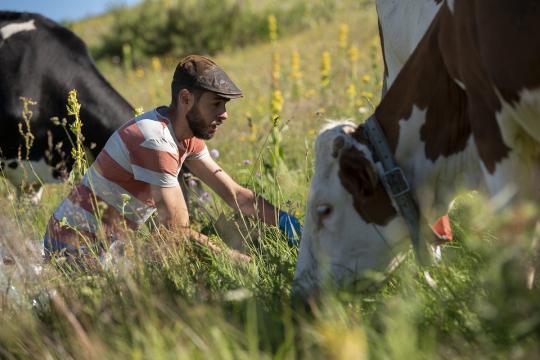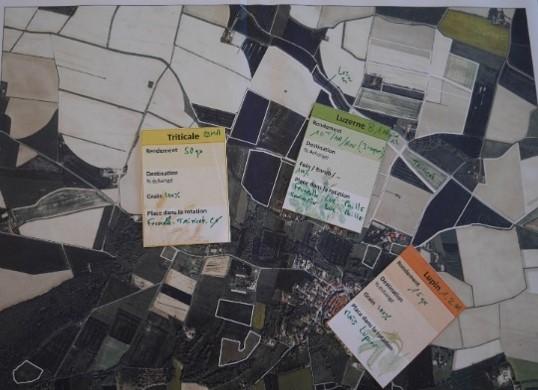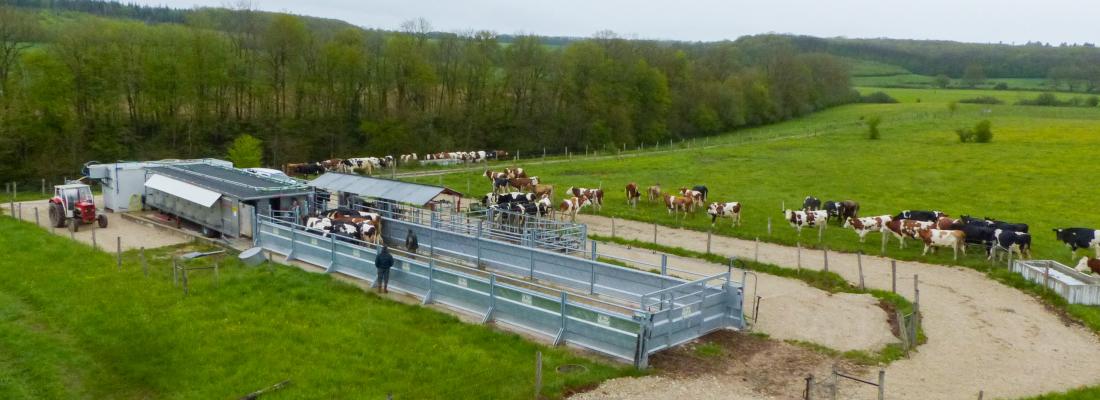Ressources dossier
AgroecologyExperiments in the field!
Published on 24 January 2023
MEMIPAT: "Optimising grassland characteristics via mixed grazing"

The MEMIPAT study is led by Frédéric Joly, agroecologist in the Joint Research Unit for Herbivores (INRAE Centre of Clermont-Auvergne-Rhône-Alpes).
Traditionally, Europe has largely used a successive multispecies grazing regime: cows graze a plot first, and then sheep take their turn. However, in nature, large grassy areas like savannahs host wildlife species of different sizes that display diverse feeding behaviours. The MeMiPat project applied this observation to an agricultural context and explored the impacts of mixed grazing with ewe lambs and Holstein heifers. The latter have a docile nature, making them well suited to such systems. The project’s objective was to describe the individual feeding behaviour of each species and the animals' combined impact on grasslands. Cows are less selective foragers, and they graze on tall grasses. The ewe lambs can thus consume the more nutritious. low-lying grasses. This system promotes more effective grassland use and improves lamb health. Ewe lambs are frequently infected with strongyles, parasites that are prevalent in ruminants reared outdoors. However, compared to control animals, ewe lambs in mixed grazing systems were less likely to become infected and grew twice as fast.
COCCINELLE: “Co-constructing sustainable alpine livestock farming systems that promote animal welfare and product quality”

Coccinelle is led by Matthieu Bouchon, Dominique Pomiès and 4 other animal husbandry scientists in the Low Mountain Ruminant Farming Systems Facility (Herbipôle) and the Joint Research Unit for Herbivores (INRAE Centre of Clermont-Auvergne-Rhône-Alpes).
Developed in collaboration with industry and environmentally minded stakeholders, this project explores an alpine dairy production system with a focus on incorporating public expectations around product quality, improving animal welfare, and boosting environmental sustainability. It builds on 20 years of experiments demonstrating how grazing in floristically diverse, high-altitude grasslands (containing 30–80 species) positively impacts the quality of milk and cheese, which end up with high levels of omega-3 fatty acids and low levels of saturated fat. The aim is to develop a 100% grass-based system that is low in inputs. The life cycle of the animals (i.e., reproduction, calving, growth, lactation) is organised around grassland growth, such that grazing alone allows summer food needs to be met. The calves are born in the spring and remain with their mothers until weaning. They thus benefit from the grassland from a young age. Regardless of when cutting occurs, permanent grasslands maximise biodiversity while producing different hay types that are adapted to the animals' winter needs. Using a participatory research approach, the project team reached out to a local collective of livestock farmers to obtain guidance on the experiment’s future technical choices around crossbreeding, lengthening lactation duration, and testing crop suitability as winter feed for cattle grazed in alpine regions.
TRIPL'XL: “Lowering milk production costs by putting large herds out to pasture”
Study led by Luc Delaby, an animal husbandry scientist in the Joint Research Unit for the Physiology, Environment, and Genetics for the Animal and Livestock Systems (PEGASE, INRAE Centre of Brittany-Normandy).
Tripl'XL arose out of 30 years of experimental research on dairy production systems near Pin-au-Haras in northwestern France. This work quantified the value of grazed grass, the impacts of its forms of usage, and the compatibility of certain dairy breeds with certain grassland systems. The project is exploring the ways in which farmers with large herds can return to plains-based grazing systems. The research is being carried out with collaborators in Ireland, a country known for its low-cost dairy production. As a result, 150 dairy cows are grazing on 10 ha of grassland in accordance with a plan that was adjusted via Patur'Plan grazing management software, which was developed by INRAE and the company ElvUp. During the winter or if summer forage is lacking, the cows are fed grass silage and hay produced on the farm. Breeding takes place over a short period (3 months) so that calving coincides with spring grass growth. To assess the effects on milk quantity and the benefits for reproduction, cows receive moderate amounts of concentrates at certain points during lactation. The project is examining the impacts of grazing on animal health and welfare using a participatory science approach. This work is occurring cooperatively with industry stakeholders and everyday citizens via the Regional Innovation Laboratory for Livestock Farming in the west of France (LIT Ouesterel).
DYNAMIX: “Mixed crop-livestock systems: reflecting collaboratively at regional scales”
Dynamix is a serious game created by Julie Ryschawy, agricultural scientist in the Joint Research Unit for Agroecology, Innovations and Territories (AGIR, INRAE Centre of Occitanie-Toulouse).

In Ariège, there is agricultural segregation in space: livestock farms are found on the piedmont slopes, while farms growing grain crops occur on the plains. While these specialised farms are thus distanced from each other, they could nonetheless re-establish synergistic relationships by building adapted supply chains. Dynamix is exploring a participatory approach to reforging links between livestock farmers and grain farmers. The project has developed a board game that players can use to design buying and selling scenarios for grains, forage, and manure. They have game pieces labelled “supply”, “demand” and “logistics”. The method incites collective reflection at the plot level, farm level, and regional level. By combining different evaluation software programmes that utilise real-life data, the game’s modelling system makes it possible to estimate scenario-specific gains in working time and costs. This multicriteria approach is a reliable decision-making tool. Players can answer the following questions: what gains will result for this scenario? Which criteria will improve? Which will degrade? This game-based approach was tested by the Ariège Chamber of Agriculture between 2017 and 2020, but its reach may extend beyond France. Indeed, agricultural stakeholders in Scotland, Denmark, the US (California), and Brazil are all exploring its utility.
OASYS: “Diversifying cover crops to allow year-round grazing even when summer forage is lacking”
OasYs is a study led by Sandra Novak, agricultural scientist in the Lusignan Experimental Unit for Forage, Ruminants, and Environment (FERLUS, INRAE Centre of Nouvelle-Aquitaine-Poitiers.
OasYs is developing a mixed crop-livestock system in which animals graze on diverse cover crops throughout the year. The objective is to produce milk using water- and energy-efficient practices. The project is taking place in western central France. This area’s oceanic climate, characterised by marked summer droughts, prefigures conditions expected in 2050 in France’s Grand-Ouest region. The latter is responsible for 50% of French milk production. Oasys aims to align the animals’ nutritional needs with grassland availability via an adapted farming strategy that utilises reproduction, cross-breeding, and lengthened lactation. During periods of drought or in the winter, part of the herd is dried off to reduce forage needs. Animals graze on suitable cover crops (millet & clover, sorghum, maslin, chicory, and beets) in addition to consuming conserved forage. This work is also testing the utility of fodder trees, which provide shade and food, in an agroforestry system that is one-of-a-kind in Europe. It is composed of 200 pollarded trees, 1,600 fodder vines, and 600 shrubs, forming an arboretum where it is possible to evaluate the nutritional value of leaves from 50 tree species and thus meet the demands of livestock farmers.
MULTISWARD: “Multispecies grasslands for sustainable livestock production in Europe”
This study is led by Jean-Louis Peyraud, Special adviser at INRAE's Scientific Directorate for Agriculture and agricultural scientist in the Joint Research Unit for the Physiology, Environment, and Genetics for the Animal and Livestock Systems (PEGASE, INRAE Centre of Brittany-Normandy).

Between 2010 and 2014, the MultiSward project assessed the use and management of multispecies grasslands composed of grass-and-legume associations in different European farming systems. Fifteen partners evaluated metrics for plant cover, milk production, (and meat production) for a variety of grazing regimes in 10 European countries with different soil, climatic, and socioeconomic conditions. The countries studied ranged from France to Poland and from Italy to Norway. The results have shown that grasslands are advantageous because they boost land productivity while also generating environmental benefits. The scientists quantified the economic, agricultural, and nutritional advantages of different setups, providing support for the idea that herbivores can be sustainably farmed. The project’s findings are available in a free book. The goal is to promote reflection on the different grass-based production models used in Europe.
ASTER: “From organic dairy production to multicrop, multi- livestock systems”
ASTER is a research led by Amandine Durpoix and Laurent Brunet alongside other engineers and research technicians at the Research Unit for Agroecosystems, Territories, and Resources (ASTER, INRAE Centre of Grand Ouest-Nancy).

ASTER is exploring the self-sufficiency and sustainability of mixed crop-livestock systems using a step-by-step design method that adapts to any constraints encountered.
Between 2006 and 2015, the team compared two organic dairy systems, one based entirely on grass and the other utilising mixed crop-livestock practices. Their findings underscored the economic profitability of lower-input systems (0 fertilisers, 0 concentrates, less fuel oil). Also highlighted were their environmental benefits: increased biodiversity, reduced GHG (CH4 and NO2) emissions per litre of milk, and lower levels of soil nitrogen pollution. In 2016, the team built on its prior work by further diversifying its organic production systems, notably by adopting a mixed model that combined multiple crops and livestock species.
Annual crops (70 ha) have been converted to species destined for human consumption (e.g., milling wheat, lentils, sunflowers, field vegetables). A flock of 130 sheep and a drove of 30 fattening pigs, all raised in the open air, have joined the herd of 90 dairy cows.
Fed exclusively on grass, the ruminants make the most of the permanent and temporary pastures, even those far from farm facilities. Sometimes grazing is mixed. The system displays several original approaches: the dairy cows are milked once a day, either indoors or out in the field, and the replacement heifers are raised by a dozen or so nurses, which reduces health issues and stimulates growth, allowing the heifers to calve at as early as 24 months.
-
Sarah-Louise Filleux
(Send email)
Author / Translated by Jessica Pearce
Direction de la communication
